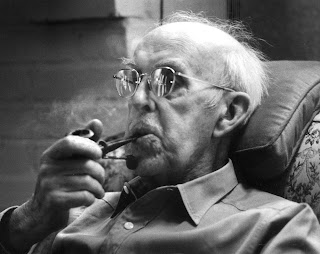By William E. Martin
Sanford Vaughn was a swell guy and a pilot's pilot. He could "fly the crates they came in," as some would say. When I bought the J-3 Cub from Warner Kenyon, he suggested I have Sanford do my annuals. Sanford had a beautiful private airport in Chillicothe, Ohio, with lots of flat surrounding farm land. The approaches were excellent from any direction, and he always kept the field mowed like a golf course. It was always a pleasure to land there.
Sanford owned a red Pitts Special, which he built himself and used for aerobatics at air shows, and he could fly everything from the Pitts to a C-47, the military version of the Douglas DC-3. And, he was also an excellent aircraft mechanic.
One beautiful day, I flew Col. William C. Lambert, a resident of Ironton, OH and one of the top American aces of World War I, to Vaughn's airport. Vaughn was so honored to meet Col. Lambert that he placed two lawn chairs on the edge of his strip, rolled his Pitts out of the hanger, and put on a private air show for the two of us. As Vaughn swooped low over the field doing a series of snap rolls, Lambert turned to me and said, "I used to be able to do that."
Sanford played a banjo and also had an old piano inside his hanger. One day he found out that I played piano, and he would never let me leave there until we had a jam session. And, that happened every time I landed there.
Sanford Vaughn died in Chillicothe, OH, on February 5, 1982, at the age of 71.
Notes by Ronald W. Kenyon
The Pitts Special, a single-engine biplane, was created by Curtis Pitts [1916-2005] and first flew in 1944. The aircraft was designed for aerobatics and won many competitions in the 1960's and 1970's, before being dethroned by higher-performing monoplanes.
Originally, Pitts manufactured the Special, but in 1962 he produced and released detailed plans enabling hundreds of pilots like Sanford Vaughn to assemble their own home-built Specials.
The design of the Pitts Special has been refined over the years, but still remains quite close to Curtis Pitts's original conception. Many Pitts Specials are flying today and compete in high-performance aerobatic competitions. Kits are available for home-builders and one company, Aviat Aircraft, manufactures and sells Pitts Specials.
Col William C. Lambert shown with a pipe in the unusual pipe rest that he invented; it allowed a smoking pipe to be rested on the smoker's chin. Photo courtesy William E. Martin.
Col. Willliam Carpenter Lambert [August 18, 1894 – March 19, 1982] was born in Ironton, OH, across the Ohio River from Russell, KY. He took his first airplane flight in a Wright biplane on July 4, 1910. In 1917, Lambert joined a Canadian unit of the Royal Flying Corps. He was the second-ranking American ace of World War I, participating in 32 aerial combats and scoring 21 1/2 air-to-air victories, 4 1/2fewer than "Ace of Aces" Eddie Rickenbacker. [Half the credit for one kill went to another pilot.] Authorities agree there may have been more victories for Col. Lambert, but record-keeping was sometimes lost during the heat of battle.
Col. Lambert was awarded the Distinguished Flying Cross by the Prince of Wales in a ceremony at the British Embassy in Washington, DC in 1919.
According to aviation historian William E. Martin, Col. Lambert was left out of the earlier history books because he flew for the Royal Flying Corps and the Americans didn't claim him. Neither did the British, because he was an American. It wasn't until 1968 that the late Royal Frey, curator of the Air Force Museum, discovered Lambert's score and came to Ironton to meet him.
Col. Lambert related his wartime experiences in western France in his 1973 memoir, Combat Report.
More information on Col. Lambert.compiled by Wright State University.
Sources: American Aces of World War I, theaerodrome.com
November 26, 2011
Revised December 28, 2011
Copyright © 2012 Ronald W. Kenyon. Warning: this blog is protected under copyright. Do not plagiarize!





Sanford was my wife's grandfather. We have a picture of Lisa sitting in the cockpit of he Pitts before he got the skin on it. She was probably 4 or 5 years old.
ReplyDelete